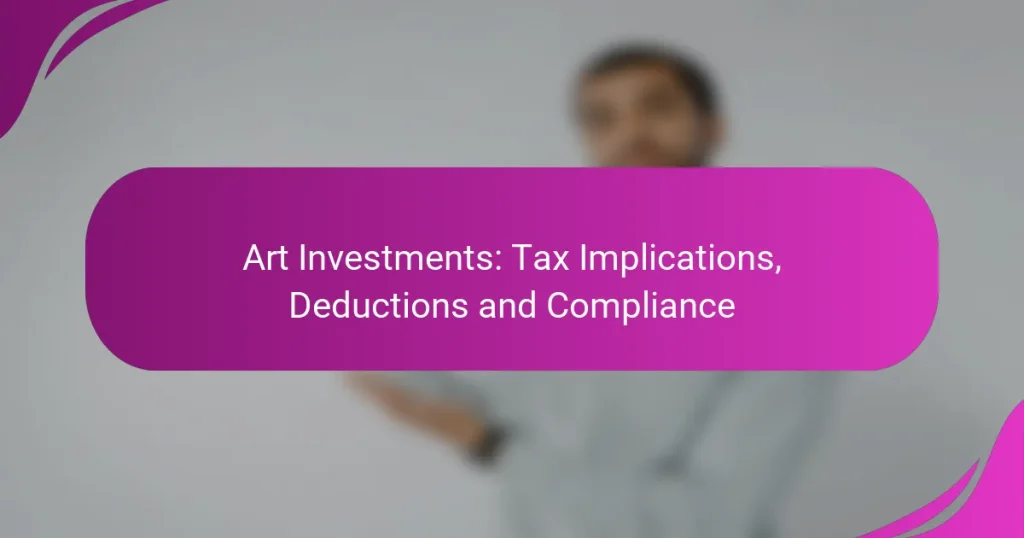Investing in luxury products, particularly art and collectibles, presents a unique opportunity for wealth growth and personal enjoyment. With options ranging from contemporary art to classic paintings and limited edition prints, understanding the nuances of each category is crucial for potential investors. Careful evaluation of provenance, market demand, and condition can significantly impact the value and return on investment, while also navigating the inherent risks associated with market volatility and liquidity challenges.
Art Advisors: Roles, Benefits and Selection
Market Trends: Impact on Valuation and Investment Decisions
Art Investments: Tax Implications, Deductions and Compliance
Auction Houses: Comparison, Services and Fees
Art Collection Protection: Insurance, Storage and Maintenance
Fine Art: Investment Strategies, Market Insights and Beginner Tips
What are the best luxury art investment options in the US?
The best luxury art investment options in the US include contemporary art, classic paintings, photography collections, art sculptures, and limited edition prints. Each category offers unique opportunities and risks, making it essential for investors to understand their characteristics and market dynamics.
Contemporary art
Contemporary art refers to works created in the late 20th and early 21st centuries, often reflecting current cultural and social issues. Investing in contemporary art can be lucrative, as emerging artists may see significant appreciation in value over time.
When considering contemporary art, focus on artists with a growing reputation and a solid exhibition history. Attend art fairs and galleries to discover new talent and gauge market trends.
Classic paintings
Classic paintings typically include works from renowned artists of the past, such as Van Gogh, Picasso, or Monet. These pieces often hold their value well and can appreciate significantly, especially if they are part of a limited supply.
Investors should research auction results and gallery sales to identify high-demand artists. Be aware of provenance and condition, as these factors can greatly influence a painting’s value.
Photography collections
Photography collections encompass works by both historical and contemporary photographers. This investment category has gained traction, with certain pieces fetching high prices at auctions.
Consider focusing on limited edition prints from established photographers, as these tend to appreciate more reliably. Ensure proper storage and framing to maintain the condition of the photographs.
Art sculptures
Art sculptures can range from small pieces to large installations, created by both established and emerging artists. They often serve as focal points in homes or galleries, making them appealing to collectors.
When investing in sculptures, consider the material, size, and artist’s reputation. Limited editions or unique pieces generally offer better investment potential, so research the artist’s market presence before purchasing.
Limited edition prints
Limited edition prints are reproductions of original artworks, produced in restricted quantities. These prints can provide a more affordable entry point into art investment while still offering potential for appreciation.
Look for prints signed by the artist and verify the edition number. Higher numbers of prints may dilute value, so aim for lower edition sizes when possible. Keep an eye on market trends to identify which artists’ prints are gaining popularity.
How to evaluate collectibles for investment?
Evaluating collectibles for investment involves assessing their provenance, market demand, and condition. These factors significantly influence their potential value and return on investment.
Provenance and authenticity
Provenance refers to the history of ownership and the authenticity of a collectible. Items with a well-documented history and verified authenticity tend to command higher prices. Always seek certificates of authenticity or reputable appraisals to ensure the item is genuine.
For example, a painting with a clear lineage from a recognized artist is more valuable than one without such documentation. Collectors often prefer items that can be traced back to significant exhibitions or previous owners.
Market demand and trends
Understanding market demand and trends is crucial when evaluating collectibles. Research recent sales, auction results, and current trends in the collectible market to gauge interest levels. Items that are currently popular or have a growing following may yield better investment returns.
For instance, vintage toys or rare coins may fluctuate in value based on collector interest. Keeping an eye on social media platforms and collector forums can provide insights into emerging trends.
Condition and restoration history
The condition of a collectible directly impacts its value. Items in excellent condition typically fetch higher prices, while those with significant wear or damage may be less desirable. Always assess the physical state of the item before investing.
Additionally, consider any restoration history. While some restoration can enhance value, excessive or poorly done repairs may detract from it. A collectible that has been well-preserved and minimally restored is usually the safest investment.
What are the risks of investing in luxury collectibles?
Investing in luxury collectibles carries several risks that potential investors should carefully consider. These risks include market volatility, liquidity issues, and costs associated with storage and insurance.
Market volatility
The market for luxury collectibles can be highly volatile, with values fluctuating based on trends, economic conditions, and buyer demand. For instance, a particular art piece may appreciate significantly during a booming economy but lose value during a downturn.
Investors should be aware that the luxury collectibles market does not always follow traditional market patterns, making it essential to stay informed about market trends and shifts. Regularly reviewing auction results and sales data can provide insights into current market conditions.
Liquidity issues
Luxury collectibles often face liquidity challenges, meaning they may not sell quickly or at a desired price when you want to cash out. Unlike stocks or bonds, which can be sold on exchanges, collectibles typically require finding a buyer willing to pay a fair price.
To mitigate liquidity risks, investors should consider the demand for specific items and the potential resale market before purchasing. Engaging with reputable dealers and attending auctions can also help in understanding the liquidity landscape for various collectibles.
Storage and insurance costs
Investing in luxury collectibles involves additional expenses for storage and insurance. Proper storage is crucial to maintain the condition and value of items, which may require climate-controlled environments or specialized display cases.
Insurance is another important consideration, as it protects against theft, damage, or loss. Investors should budget for these ongoing costs, which can range from a few hundred to several thousand dollars annually, depending on the value and nature of the collectibles.
How to choose a reputable art dealer in the US?
Choosing a reputable art dealer in the US involves verifying their credentials, assessing their inventory, and understanding their commission structure. A trustworthy dealer should have a solid reputation, expertise in their field, and transparent pricing.
Check credentials and reviews
Start by verifying the dealer’s credentials, such as their membership in professional organizations like the American Art Dealers Association (AADA) or the International Fine Print Dealers Association (IFPDA). Look for online reviews and testimonials from previous clients to gauge their reliability and service quality.
Additionally, consider reaching out to other collectors or artists for recommendations. Personal referrals can provide valuable insights into a dealer’s trustworthiness and professionalism.
Evaluate their inventory and expertise
Assess the dealer’s inventory to ensure it aligns with your interests and investment goals. A reputable dealer should specialize in specific art forms or periods, demonstrating a deep understanding of their offerings.
Examine the quality and provenance of the artworks available. A knowledgeable dealer will provide detailed information about each piece, including its history, condition, and market value, helping you make informed decisions.
Understand their commission structure
Before engaging with an art dealer, clarify their commission structure. Dealers typically charge a percentage of the sale price, which can range from 10% to 50%, depending on the artwork and the dealer’s reputation.
Ensure you understand any additional fees that may apply, such as shipping costs or insurance. Being aware of the total expenses will help you evaluate the overall investment and avoid unexpected costs.
What are the tax implications of art investments?
Investing in art can have significant tax implications, particularly concerning capital gains tax when you sell a piece for more than you paid. Understanding these tax responsibilities is crucial for maximizing your investment returns and ensuring compliance with local regulations.
Capital gains tax
Capital gains tax is applied to the profit made from selling an art piece that has appreciated in value. In many countries, including the United States, this tax is typically calculated based on the difference between the purchase price and the selling price of the artwork.
The rate of capital gains tax can vary significantly depending on how long you have held the artwork. For instance, in the U.S., if you hold the art for more than a year, it may be subject to long-term capital gains tax rates, which can be lower than short-term rates that apply to assets held for less than a year.
To minimize capital gains tax, consider holding onto your art investments for the long term and consult with a tax professional to explore potential deductions or exemptions that may apply to your situation. Additionally, keeping thorough records of your purchases and sales can help substantiate your claims during tax assessments.






